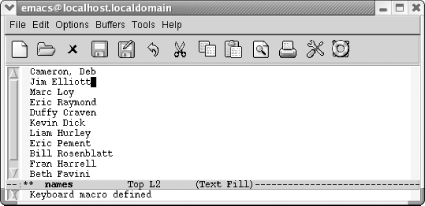6.1. Defining a Macro
| To start defining a macro, press F3 or C-x (.[2] The abbreviation Def appears on the mode line, showing that you are in macro definition mode. In this mode, Emacs records all the keystrokes that you type, whether they are commands or literal text, so that you can replay them later. To end the macro, press F4 or C-x ); you leave macro definition mode, and Emacs stops recording your keystrokes. Emacs also stops recording your keystrokes automatically if an error occurs or if you press C-g.
While you're defining a macro, Emacs acts on your keystrokes as well as recording them: that is, anything you type while in macro definition mode is treated as a regular command and executed. While you're defining a macro, you're doing completely normal editing. That way you can see that the macro does exactly what you want it to, and you can cancel it (with C-g) if you notice that the macro isn't really quite what you want. To execute your macro, press F4 or C-x e. Emacs then replays your keystrokes exactly. (You can see that F4 has two different functions relating to macros: to end a macro definition and, after it's defined, to execute the macro.) This macro is referred to as the "last" keyboard macro, with last here meaning most recent. Only one macro is the last keyboard macro. A macro ring, much like the kill ring, allows you to access a number of macros during an Emacs session. Table 6-1 shows the steps required to define and execute a macro. This macro takes a list of names in the ordinary First Name Last Name order and changes it to the frequently needed Last Name, First Name order.
Now let's be brave and assume the macro works; we'll try repeating it five times by prefacing the command to execute a macro with M-5. Of course, in real life, you'd be better off trying it once before doing anything so bold.
The macro works well, so we can finish the rest of the buffer with confidence: type M-100, then C-x e or F4. Emacs stops automatically when you reach the end of the buffer, so it doesn't matter if you repeat the macro more times than necessary. Here are a few points to remember:
If you invoke a macro and it does the wrong thing, you can use C-_ to undo it. Emacs is smart enough to realize that "undo the last command" means "undo the entire macro" rather than "undo the last command within the macro." However, if you repeat a macro multiple times using M-n, C-_ undoes only the last instance of the macro, not all the instances. |
EAN: 2147483647
Pages: 161

